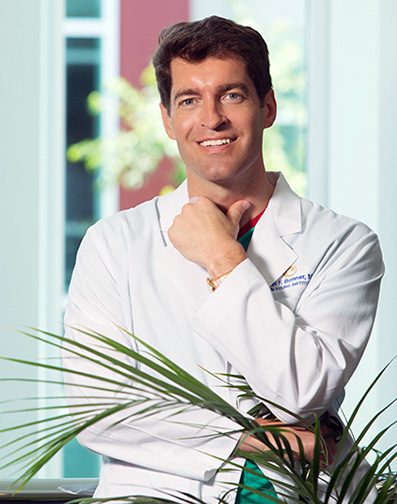 Growing up in a small farming community, Kevin Bonner developed a strong work ethic, as well as an early interest in both sports and the sciences. “To be honest, at the time, it was not much fun getting up quite early to take care of cows and chickens before walking to the bus stop,” he says, “but I think it does instill drive and character, which helps you for the rest of your life.”
Growing up in a small farming community, Kevin Bonner developed a strong work ethic, as well as an early interest in both sports and the sciences. “To be honest, at the time, it was not much fun getting up quite early to take care of cows and chickens before walking to the bus stop,” he says, “but I think it does instill drive and character, which helps you for the rest of your life.”
Kevin Bonner was a three-sport athlete in high school, but he eventually concentrated on baseball, earning him an athletic scholarship to Georgetown University. He played well; however, like many pitchers probably threw too often, ultimately sustaining an injury to his elbow. The silver lining was that his injury spurred his interest in orthopaedics and sports medicine.
After completing his undergraduate degree, Dr. Bonner attended Georgetown University School of Medicine on a scholarship from the United States Navy. He continued his training in orthopaedic surgery at the Hospital for Special Surgery/Cornell University Medical Center, where he had the opportunity to work with many of the pioneers in the field. The Navy subsequently brought him to Hampton Roads to start his career at Portsmouth Naval Medical Center. By the time he left, he was Chief of Sports Medicine. “Coming from New York, we didn’t know anything about this area,” Dr. Bonner says. “We didn’t expect to stay here, but my family and I really ended up loving the area.” He joined the Jordan-Young Institute, where he enjoys “practicing with great partners who share the same philosophy of delivering a level of care equivalent to leading academic medical centers.”
Today he focuses mainly on sports medicine and arthroscopic surgery, treating athletes from high school students to professional athletes to the weekend warrior. “Middle-aged athletes are getting older and older, which is great since I’m now in that category,” Dr. Bonner says, “and the type of injury is often dependent on the age of the athletes and their sport of choice.” It is the 60-year olds who tear their rotator cuff, but frequently the 16 year olds who tear their ACL. He sees what he calls a “nice spectrum” of patients with primarily knee and shoulder problems.
“There’s been a tremendous innovation and advances in arthroscopic surgery and sports medicine over the past 10-15 years as a result of the contribution from a worldwide orthopaedic community, particularly in shoulder cases,” he says. “Other than replacements, we’re able to do most shoulder cases arthroscopically – rotator cuff repairs and labral repairs are today truly minimally invasive, which generally translates into less perioperative pain. We can actually do more difficult cases through scope easier than an open approach due to advancements in arthroscopic techniques. I often stay up late into the morning just trying to think of what can we do next?”
In addition to his busy caseload, Dr. Bonner serves on the clinical faculty at EVMS, which gives him the opportunity to work with medical students, particularly those who are interested in orthopaedic surgery and associated research. “It is really a pleasure teaching and mentoring our EVMS students and hopefully helping them fulfill their career goals, just as others helped me. I consider myself so lucky to do something everyday that I love and hopefully, that’s evident to the students, and most importantly to my patients.” he says.
That workload alone could fill the busiest surgeon’s hours, but Dr. Bonner doesn’t stop there. He also does research, serves as faculty for many Orthopaedic conferences and writes: he’s currently working on his ninth textbook contribution. And he frequently works with physicians both nationally and internationally to develop and evaluate new techniques.
Growing out of a particular interest in cartilage surgery, he was a member of the team of physicians and scientists that developed the DeNovo NT Natural Tissue Graft, a juvenile cartilage allograft tissue that provides surgeons with an early-intervention option for the repair of focal articular cartilage defects. “These things take a lot of time. Typically years of development before release,” he says. Dr. Bonner did the first case in the world at Sentara Leigh in 2007; and now, more than five thousand of these have been done across the country.
As for evaluating new modalities, he approaches the task with trepidation: “We’re always looking for new developments and improvements for everything we do,” he notes, “but our enthusiasm to explore novel ideas to improve on current outcomes must also be tempered with appreciation of our past failures. Everyone’s looking for the ‘holy grail,’ but as we evaluate the latest technologies, we try to be both scientific and realistic.”
But he won’t stop trying. “Inherent to the privilege of practicing medicine is the incessant challenge to acquire and synthesize ever-expanding information and evidence. Medicine is always changing, always evolving, and that’s why treating patients is such a dynamic process,” he says. “People kid me about reading so much, but I believe the day we are satisfied with our knowledge and performance is the day we need to pass the torch.”
Happily, for Dr. Bonner, that day is far off in the future.

